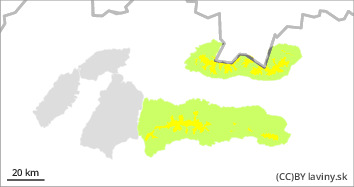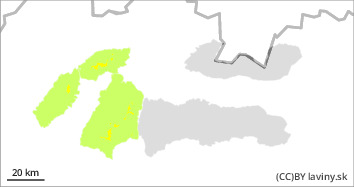
Danger level
 | 1600m |
|  |
|  |

At higher altitudes, wind-blown slabs and snow pillows.
Moderate avalanche danger (2nd degree) is declared for the highest altitudes of the Low, High and Western Tatras. There are wind-blown snow slabs and pillows in several places. Dangerous places are located on leeward slopes, gullies, mostly on northern orientation. Medium-sized avalanches may be released after high additional loads. Caution is required where old packed snow alternates with wind-blown slabs and pillows. Spontaneous avalanches are not expected. As the air cools down at lower elevations, the situation will be even more stable.
Snowpack
Wind-blown snow in the form of slabs and pillows is found mainly in the highest altitudes of the Tatras. The snow is very unevenly distributed, some places are blown down to the hard, icy ground. On others, on the contrary, a larger amount of snow is blown by the wind. At altitudes below 1600 m the snow was wet due to rain. The snow will stabilise even more as the weather cools down.
Tendency
With cooling decreasing.


